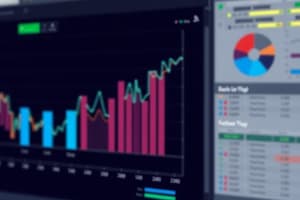Podcast
Questions and Answers
Which type of visual is NOT commonly used in Power BI?
Which type of visual is NOT commonly used in Power BI?
- Bubble clouds (correct)
- Filled maps
- Line charts
- Pie charts
What is the primary difference between calculated columns and measures in DAX?
What is the primary difference between calculated columns and measures in DAX?
- Calculated columns are stored in the data model, whereas measures are on-the-fly calculations. (correct)
- Calculated columns are used for aggregations, while measures are not.
- Calculated columns are row-based, while measures are column-based.
- Measures cannot perform logical functions, while calculated columns can.
Which function would you use to retrieve the current date in DAX?
Which function would you use to retrieve the current date in DAX?
- NOW()
- CURRENTDATE()
- GETDATE()
- TODAY() (correct)
What is a key advantage of using Power Query for data transformation?
What is a key advantage of using Power Query for data transformation?
What does the star schema model in data modeling emphasize?
What does the star schema model in data modeling emphasize?
Which of the following features enhances user engagement in Power BI visualizations?
Which of the following features enhances user engagement in Power BI visualizations?
Which of the following is a characteristic of the M language used in Power Query?
Which of the following is a characteristic of the M language used in Power Query?
What is the primary purpose of DAX formulas in Power BI?
What is the primary purpose of DAX formulas in Power BI?
Flashcards are hidden until you start studying
Study Notes
Power BI Study Notes
Data Visualization
- Purpose: Transform raw data into interactive and insightful visuals.
- Visual Types:
- Bar and column charts
- Line and area charts
- Pie and donut charts
- Tables and matrices
- Maps (e.g., filled maps, shape maps)
- KPI indicators and cards
- Customization: Adjust colors, labels, tooltips, and formatting options for clarity and emphasis.
- Interactivity: Incorporate features like filters, slicers, and drill-throughs to enhance user engagement.
DAX Formulas
- Definition: Data Analysis Expressions (DAX) is a formula language used for calculations and data manipulation in Power BI.
- Common Functions:
- Aggregate Functions: SUM, AVERAGE, COUNT, DISTINCTCOUNT.
- Logical Functions: IF, SWITCH.
- Date Functions: YEAR, MONTH, TODAY, DATEDIFF.
- Filter Functions: FILTER, CALCULATE, ALL.
- Calculated Columns vs. Measures:
- Calculated columns are computed row-by-row and stored in the data model.
- Measures are calculated on the fly and are used in aggregations.
Power Query
- Purpose: Data connection and transformation tool integrated with Power BI.
- Key Features:
- Data Import: Connect to various sources (Excel, SQL, web, etc.).
- Data Transformation: Cleanse and reshape data using functions such as remove duplicates, pivot/unpivot, and merge queries.
- M Language: The formula language used for advanced transformations and custom queries.
- Steps:
- Connect to data source.
- Apply transformations in the Power Query Editor.
- Load transformed data into the Power BI model.
Data Modeling
- Definition: The process of structuring data in a way that enables efficient analysis and reporting.
- Key Concepts:
- Relationships: Create connections between tables (one-to-many, many-to-many).
- Star Schema: Ideal data modeling technique with fact tables and dimension tables.
- Normalization vs. Denormalization: Balance between minimizing redundancy and optimizing query performance.
- Data Types: Understand the significance of data types (e.g., text, number, date) for accurate calculations and visualizations.
Report Sharing
- Methods:
- Publish to Power BI Service: Share interactive reports and dashboards online.
- Embed Reports: Integrate reports into websites or applications using embed codes.
- Export Options: Export reports to PDF or PowerPoint for offline sharing.
- Access Control:
- Manage permissions using workspaces.
- Control who can view or edit reports with role-based access.
- Collaboration: Use comments and annotations within reports for team discussions and feedback.
Data Visualization
- Converts raw data into interactive visuals for better insights.
- Offers various visual types, including bar charts, line charts, pie charts, tables, and maps.
- Customization options are available for colors, labels, tooltips, and overall formatting to improve clarity.
- Enhancements like filters, slicers, and drill-throughs create an engaging user experience.
DAX Formulas
- DAX (Data Analysis Expressions) is a formula language designed for data calculations and manipulation within Power BI.
- Commonly used functions include:
- Aggregate Functions: SUM, AVERAGE, COUNT, DISTINCTCOUNT for data summarization.
- Logical Functions: IF and SWITCH for conditional logic.
- Date Functions: YEAR, MONTH, TODAY, DATEDIFF for date calculations.
- Filter Functions: FILTER, CALCULATE, and ALL to manipulate data context.
- Distinguishes between calculated columns, which are row-based and stored, and measures, which are dynamic and used for aggregation during analysis.
Power Query
- Serves as a data connection and transformation tool within Power BI.
- Allows data import from multiple sources, such as Excel, SQL databases, and web services.
- Offers data cleansing and reshaping capabilities with functions like removing duplicates and merging queries.
- Utilizes M Language for advanced transformations and custom query creation.
- Involves a systematic process from data source connection to loading the modified data into the Power BI model.
Data Modeling
- Involves structuring data to facilitate efficient analysis and reporting.
- Key concepts include establishing relationships between tables (one-to-many, many-to-many).
- Star Schema is recognized as an effective modeling approach using fact and dimension tables.
- Balances normalization (reducing redundancy) and denormalization (optimizing query performance).
- Recognizes the importance of data types (text, number, date) to ensure accurate calculations and visualizations.
Report Sharing
- Reports can be published to the Power BI Service for online sharing and access.
- Embedding reports into websites or applications can be done using specific embed codes.
- Offers export options to PDF or PowerPoint, enabling offline sharing capabilities.
- Access control is vital; permissions can be managed through workspaces to regulate who can view or edit reports.
- Collaboration features in reports include comments and annotations for effective team discussions and feedback.
Studying That Suits You
Use AI to generate personalized quizzes and flashcards to suit your learning preferences.




